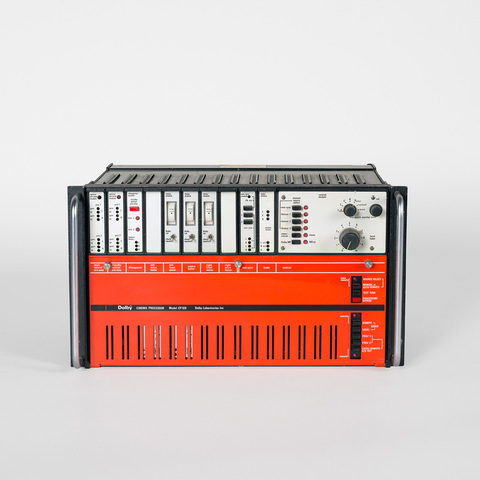Réducteur de bruits
Fiche détaillée
Type de l'appareil
processeur de son Dolby Stereo magnétique et optique ; un réducteur de bruit Dolby A-Type et deux réducteurs Cat. 22
Auteurs
Dolby Ray M.
London
Fabricants
Dolby Laboratories
Wootton Bassett, Wiltshire, SN4 8QJ
Utilisateurs
Dolby Ray M.
London
Distributeurs
Informations non disponibles
Sujet du modèle
Informations non disponibles
Objectif
Informations non disponibles
Taille de l'objet
Ouvert :
Informations non disponibles
Fermé :
Longueur : 33 cm
Largeur : 48.5 cm
Hauteur : 27 cm
Diamètre :
Informations non disponibles
Taille de la boîte de transport
Informations non disponibles
Remarques
Marques : "Dolby Cinema processor Model CP 100 Dolby Laboratories Inc" ; "Dolby Cinema processor Model CP100 Made in England Dolby Laboratories Inc San Francisco London".
Le CP 100 a servi pour la première fois à Londres en février 1975 pour la projection du film Tommy (Ken Russell 1975).
"CP 100. The Dolby CP100 Cinema Processor is designed for the reproduction of all current and presently foreseeable film sound-track formats including conventional optical and magnetic tracks, Dolby encoded monaural optical tracks, Dolby encoded magnetic sound-tracks and the new stereo optical release prints. Up to three noise reduction modules can be incorporated. Typically, three channels of theatre equalization, as in the E2, will be incorporated, but facilities exist for five channels of equalization and the connection of an external quadraphonic decoder" (EDBU Review, décembre 1979).
"The CP100 is a complete cinema control centre allowing reproduction of all sound formats. In addition it contains all the equipment necessary for playback of Dolby Stereo Optical Soundtracks. Modular construction is used to allow extra plug-in (optional) modules for playback of magnetic tracks or any other existing or future format through easy connection to outboard equipment. Imputs are provided for optical solar cells, for up to 6-track magnetic films, for two stereo non-sync sources, and for a PA microphone. Full remote facilities are provided, allowing control from each projector (two remote control units Cat. n° 88 supplied with CP100) or from automatic programmers. [...] Since the introduction of sound on film in the 1930's, the quality and entertainment potential of the image in the motion picture theatre has improved beyond recognition, but the sound-track itself has not made comparable progress. Despite the quality capabilities of magnetic sound-tracks, it now seems certain that most films will continue to be released withe optical sound-tracks, primarily because of production cost saving and the reluctance of many theatre owners to convert projection room plant. The conventional optical sound-track leaves much to be desired with respect to sound quality, although it is simple and economical from a production and exhibition standpoint. Sophisticated and affluent audiences which are accustomed to high fidelity sound reproduction in the home are increasingly likely to become conscious of these quality shortcomings. Much of the poor quality of the optical track can be shown to be due to the way in which it is used, rather than to any inherent defect in the optical recording principle itself. The application of the Dolby Noise Reduction System to optical recording and reproduction results in a quality comparable to that of magnetic recording. This quality is available in the theatre with little modification of existing equipment, and the release print is compatible for use with an unconverted system. of course, these advantages also apply to Dolby 70 mm magnetic prints, and several prints have been released in this format. The advantages of 70 mm prints over 35 mm are in the picture quality ; there are now few high quality 35 mm magnetic prints since 35 mm optical stereo films are superior in sound quality and the picture quality is of course the same. To achieve the benefits which the application of Dolby Noise Reduction can provide, standards, production techniques, and equipment and practice in the projection room must be changed, but the change is in the direction of a simpler set of techniques which give results superior to any yet obtained with optical sound-tracks. With the introduction of the Dolby encoded optical sound track, high fidelity reproduction in the theatre becomes possible. Such a track gives acceptable results in an unequipped theatre when played through a conventional Academy filter, though when played through Dolby Cnema Noise Reduction equipment can be compared favorably with those of any other professional recording medium. Additionally, the benefits of noise reduction are sufficient to allow high fidelity reproduction from a stereo optical track. Dolby equipment is thus able to bring the quality of sound avalaible from an optical track from low fidelity monaural reproduction to the highest quality of multi-channel stereo reproduction. Dolby Cinema equipment has been designed as a flexible but comprehensive package for the necessary electronic equipment" (Dolby Model CP 100 Cinema Processor Installation Manual, Dolby, s.d.).
"During 1975, Dolby Laboratories gave demonstrations to industry personnel in London and Hollywood, showing the application of Dolby noise reduction and equalization techniques to stereo variable-area soundtracks. Dolby Laboratories also introduced the Model CP 100 cinema processor. This compact unit contains all the necessary noise reduction, equalization and control circuitry (with the exception of power amplifiers) to play back conventional optical tracks. Dolby encoded mono and stereo optical soundtracks, and conventional magnetic stripe tracks. Optional plug-in accessory cards enable the unit to be used also for Dolby encoded magnetic stripe formats, 4 and 6 tracks, and Dolby encoded quadraphonic and Quintaphonic tracks. Fourteen films were realised with Dolby-encoded soundtracks, the majority monaural optical, two with stereo optical tracks, two with Dolby encoded magnetic stripe, and one with Dolby encoded Quintophony. At this time of writing, Nashville, which has a Dolby encoded magnetic stripe format, is a preliminary nominee for the Academy Award for best sound, 1975" (SMPTE Journal, May 1976, p. 276).
Bibliographie
Dolby Model CP100 Cinema Processor Installation Manual, London, Dolby, s.d.
"Un montage rationnel pour la réduction des bruits de fond : la méthode Dolby", La Technique cinématographique, mai 1969, n° 307, p. 2-4.
SMPTE Journal, May 1976, p. 276.
